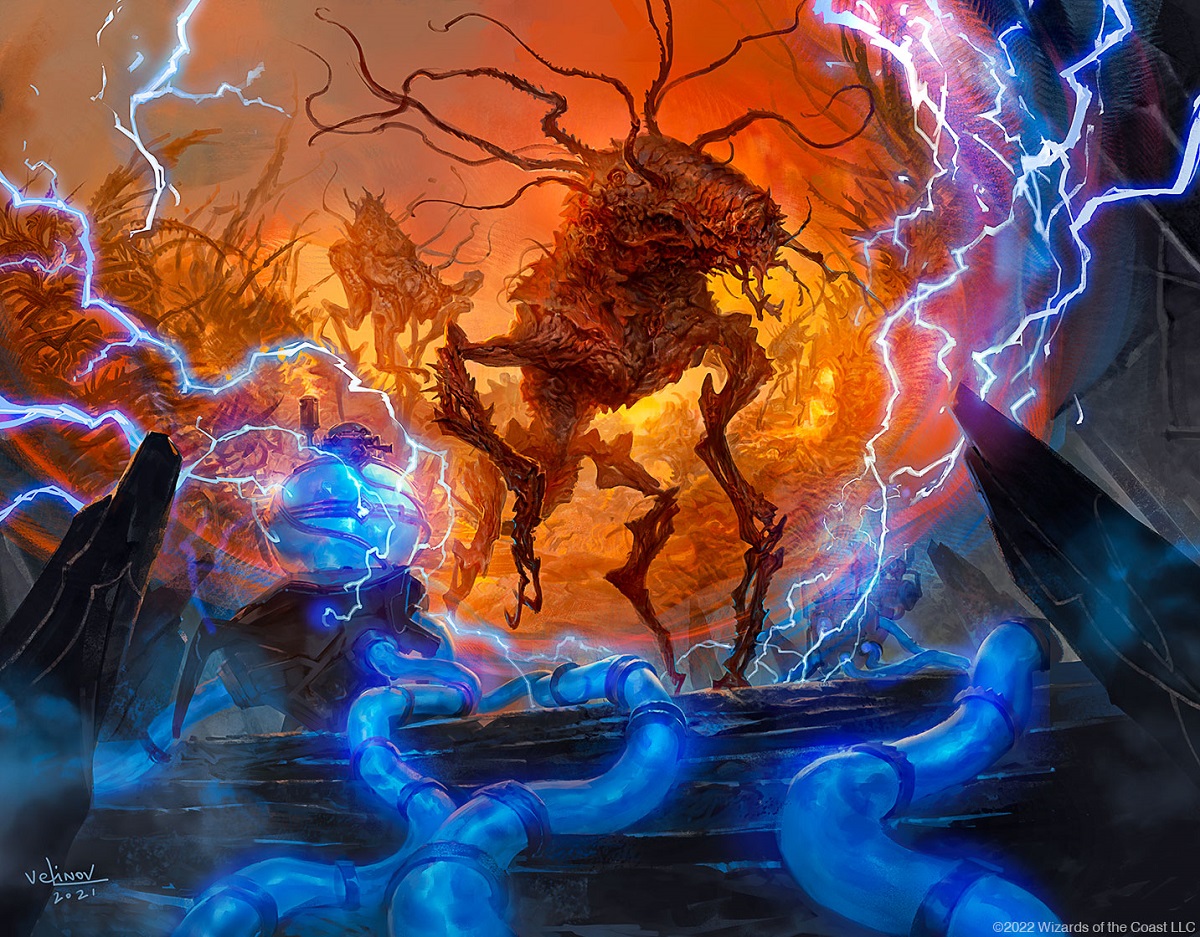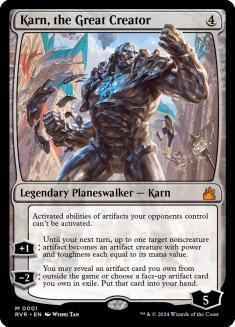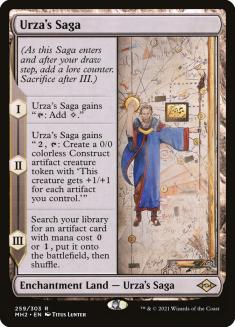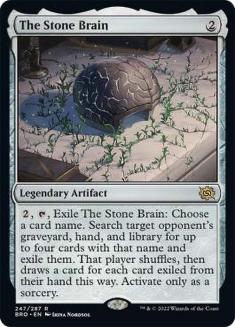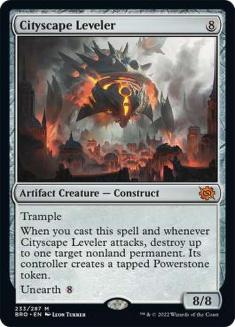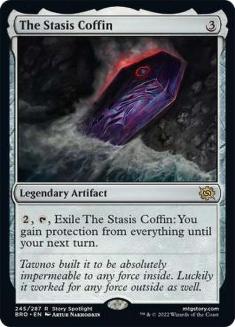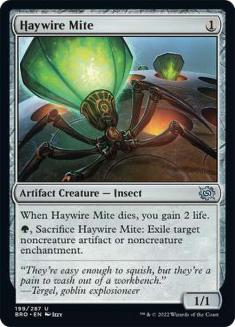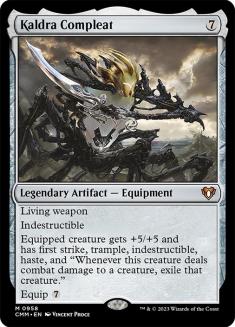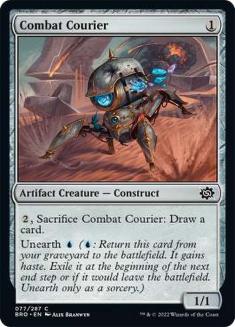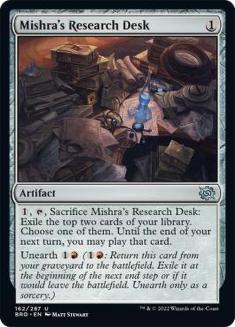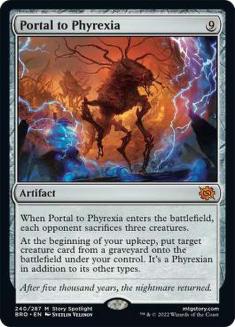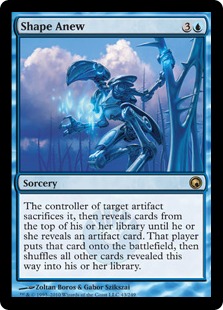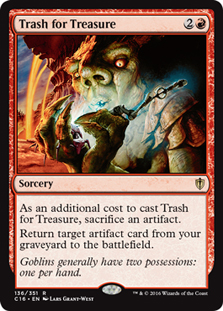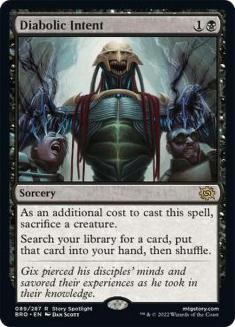The Brothers’ War had potential to be a dangerous set for Modern. The first major set release to fall in Modern’s orbit almost twenty years ago, Mirrodin, showed that an artifact-themed set without the right guardrails could actually come close to killing Magic. Despite the lessons learned from that experience, New Phyrexia and Kaladesh both had lasting and warping effects on every format they touched.
This trip into antiquity looks to be a lot safer – for now.
These days, any discussion of new artifacts centers around two cards: Karn, the Great Creator and Urza’s Saga. Both gain a lot from The Brothers’ War, and the rare deck that can support both at once has a lot to enjoy this preview season. Most Karn decks are locked into that status and enjoy it, but a deck like Amulet Titan that has flirted with Karn in the past has compelling reasons to come back to it now.
Last week I went over when you should – or, more likely, should not – turn to The Stone Brain as a regular sideboard card. In one sense, Karn saves you from yourself here; it gives you reasonably consistent access to The Stone Brain, but only when you know you want it. It can’t be your first or only form of disruption, as the combo decks in Modern reliably win before Karn can deliver and open the Brain, but it imposes an immediate deadline for the opponent to do their thing.
That’s just the start of this set’s bounty for Karn:
In this incredibly deep card pool with several artifact-heavy sets, there are surprisingly few good artifacts to cheat onto the battlefield or cast when you have an abundance of mana. Fittingly for this set’s lore, Karn in Modern usually means Urza’s Tower and friends – if you can cast Karn, you can cast almost anything the turn after. Sundering Titan devastates Modern manabases based around shocklands and Triomes but can’t deal with existing threats.
Cityscape Leveler fills that void admirably. The Eldrazi-esque ‘when you cast…’ clause and the unearth text both give Leveler a vital immunity to Counterspell – and unearth even exiles Leveler so that Karn can grab it again! In a world where Leyline Binding is a common removal spell, Leveler threatens to unlock another threat from Binding while presenting a substantial threat in its own right. Casting Meteor Golem always felt embarrassing. Casting this will feel exhilarating.
Meanwhile, I doubt The Stasis Coffin will find its way into many sideboards. If your opponent has a big enough battlefield presence that you want an effect like this, they can attack your Karn on their turn instead (as Coffin doesn’t grant planeswalkers protection) and waste your investment. This effect could theoretically be useful against some combo decks, but the popular combo decks these days are either full of creatures that can kill Karn or can win even through that protection with cards like Thassa’s Oracle.
Haywire Mite, an innocuous Insect, may be the most important Modern card in the entire set. There have always been a handful of Naturalize effects available to artifact decks, but these were unimpressive at best and uncastable at worst. There’s no need to grit your teeth and sleeve up Sylvok Replica anymore – Haywire Mite is a game-changer. It’s cheap and efficient enough that you can happily include it in a variety of decks, and this matters in a literal sense for cards like Chord of Calling – Golgari Yawgmoth can Chord for this and activate it to remove some nuisance without needing many resources. For Karn, this mitigates the hefty upfront investment you have to make to unlock his flexibility. As a cheap blocker that gains life, it can also protect Karn or you.
Few of the artifacts and enchantments you care about removing are creatures, so that restriction doesn’t change much. Exiling that target doesn’t often matter but is critical when it does – and it makes it possible for Mite to remove Kaldra Compleat at all. From Amulet of Vigor and Colossus Hammer to Blood Moon and Underworld Breach, many Modern decks rely heavily on specific artifacts and enchantments that Mite can happily feast upon – and even the more generic fair decks will often offer up a Leyline Binding.
That would earn it a guaranteed spot in various toolboxes, but that’s just the start. You can expect to see a lot of Mites because of how well it works with and against one of the format’s best cards.
Haywire Mite singlehandedly adds a whole new layer of flexibility to Urza’s Saga as its first eligible Naturalize effect. This is a big boost to any Saga deck with green – mostly just Amulet Titan at the moment, but also the occasional copy of Hardened Scales or Jund Saga – and a strong incentive for other Saga decks to splash green if possible. Mono-White Hammer can support a light splash easily thanks to Horizon Canopy and Springleaf Drum. Grinding Breach is sometimes seen splashing green for Wrenn and Six, and this is another convincing argument for that.
Mite is also an incredible tool against Urza’s Saga. The various Saga decks present a range of appealing and important targets for Mite, but you will often be keen to hit Saga itself. This creates an interesting dynamic in Saga mirrors – if you played the first Saga, you can activate your Saga to create a Construct on their end step and again in response to the final chapter, find Mite, then play a land and use Mite on their Saga to leave you far ahead. Sometimes Mite will play an analogous role to the Aether Spellbomb or Pyrite Spellbomb found in other Saga decks, giving you giant Constructs not just more power but cover against things that can ignore them.
This set is also full of what the Fifth Dawn design team referred to as ‘cogs’ – these small role-players that help a larger machine run smoothly, even if it’s not immediately clear what that machine looks like. I have visions of milling myself with Emry, Lurker of the Loch and Grinding Station; unearthing Combat Courier returning Sword of the Meek… and then what? That last part is the most difficult and interesting, but Courier helps to fill in an earlier step.
Similarly, Mishra’s Research Desk is a repeated source of additional cards or fodder for things that care about sacrificing artifacts that can also be found by Urza’s Saga. Experimental Synthesizer hasn’t made the impact I hoped for, and this card is less abstractly powerful, yet worth filing away for future use.
At the other end of the spectrum, Portal to Phyrexia might be the expensive artifact payoff we’ve been waiting for. Trash for Treasure and Shape Anew have existed as fun build-arounds for a while, but there wasn’t anything worth jumping through those hoops for previously. Portal should stabilize most battlefields and provide you with a steady stream of threats every turn. It has an obvious vulnerability to cards like Teferi, Time Raveler or Boseiju, Who Endures, but your own Teferi can set up Shape Anew at the end of the opponent’s turn to ensure at least one creature comes back before they can fight over the Portal.
This early sketch is a good template for what a Shape Anew + Portal to Phyrexia deck might look like. Gingerbread Cabin + Shape Anew mimics the Dwarven Mine + Indomitable Creativity shell that has cemented itself as a top-tier deck, yet lets you still play the colourful Elementals that power the conventional Four-Color Control decks. You don’t have to choose between Creativity and Omnath here – Omnath even gives you the mana to hard-cast a drawn Portal to Phyrexia in a pinch!
A Commander favourite making its debut in Modern, Diabolic Intent is the ideal reprint as a card that looks dangerous but requires too much setup to break anything in practice. Golgari Yawgmoth seems like its obvious home, being a deck with sacrifice fodder, creature tutors, and a namesake combo piece, but trying to work it in there exposes the problems with the card. Yawgmoth, Thran Physician is expensive enough that you can’t Intent for Yawgmoth and cast it in the same turn – in contrast to Eldritch Evolution and Chord of Calling, which each cheat the cost of Yawgmoth in their own way. These search effects have diminishing returns, and the more proven options are still the better ones here.
This characteristically intriguing brew from aspiringspike is on the right track – you need a card that is high-impact and important enough to be worth searching for, but also cheap enough that you can chain an Intent into it. Persist and its rival Goryo’s Vengeance both qualify here.
I’ll close with a card that’s guaranteed to get people excited. It’s easy to look at Third Path Iconoclast and see ‘Young Pyromancer plus.’ but I think that misses the mark. Even decks that might have some interest in Young Pyromancer have enough assorted other types among their spells that Iconoclast is a meaningful upgrade. Every tempo deck in Modern is triggering something with Mishra’s Bauble, from Dragon’s Rage Channeler to Ledger Shredder, and Bauble also helps Iconoclast to have an immediate impact.
Iconoclast’s flexibility makes it a strong candidate for decks that would have zero interest in a normal Young Pyromancer. Grinding Breach is on the hunt for a tertiary threat to fill those final slots, and Iconoclast works well with every component, from Underworld Breach and Mox Amber to Unholy Heat and Expressive Iteration. Creating artifacts buffs your Urza’s Saga tokens but also enables a new series of infinite or semi-infinite combos with Underworld Breach and Grinding Station if you don’t have spare mana or a legendary creature for the usual Mox Amber chains. It also makes your ‘fair’ Breaches much stronger, as you can recast several spells and have something permanent to show for it.
The most likely winner of The Brothers’ War is an uncommon one-drop that adds one more option to existing strategies rather than spawning anything new, but beyond that, there’s a reasonably deep roster of possible playables to consider.

